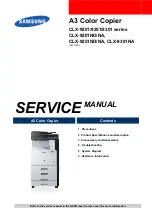
IMAGE FUSING AND PAPER EXIT
10 February 2005
6-72
6.12.5 TEMPERATURE CONTROL
The table lists default settings and variable ranges for temperature control.
External temperature
(*1)
More than 15
°
C ~
less than 30
°
C
15
°
C or lower
30
°
C or higher
Roller
Heating Press. Heat. Press. Heat. Press.
Fusing idling start
(*2)
145
10 150 10 140 10
Print ready
(*3)
155
65
Ready (standby mode)
160
115
Panel off 1
175
120
Panel off 2
165
115
Low power
mode
140 100
Energy saver
Auto off
mode
Room
temp.
Room
temp.
Mono color
155
Lamp off
Normal
paper
Full color
160
Lamp off
Mono color
165
Lamp off
>90 g/m2,
24 lb
(*4)
Full color
170
Lamp off
Mono color
165
Lamp off
Thick
Full color
170
Lamp off
Mono color
165
Lamp off
OHP
Full color
175
Lamp off
Mono color
150
Lamp off
Printing
Duplex
(*5)
Full color
155
Lamp off
Heat.: +5
Adjustable with
SP1-105-27
Press.: +0
Adjustable with
SP1-105-28
Heat.: –5
Adjustable with
SP1-105-29
Press.: +0
Adjustable with
SP1-105-30
Variable range
(*6)
100 ~
190
30 ~ 200
0 ~ +20
0 ~ –20
*1: External temperature is measured (temperature/humidity sensor) when the main switch is
turned on and when a job start signal is received.
*2: The pressure and heating rollers start idling.
*3: Fusing idling stops when both roller temperatures reach the print ready condition. The
printer can process jobs when the rollers reach this temperature during warm-up.
*4: A user tool (User Tools - System Settings - Tray Paper Settings - Paper Type) specifies the
paper type in each tray (plain, thick, or OHP). If “plain” is selected, then another user tool
(User Tools - Maintenance - Plain Paper Type) defines whether the paper in the tray is
“normal” or “>90 g/m2, 24 lb”. (
☛
5.1.2). “>90 g/m2, 24 lb” means “
greater than or equal to
90 g/m2, 24 lb”.
•
“Thick” means paper heavier than 105 g/m
2
(28 lb).
*5: Both sides of the paper are processed with the same roller temperatures.
*6: Use SP1-105 to adjust the default fusing temperatures (
☛
5.1.2).
















































